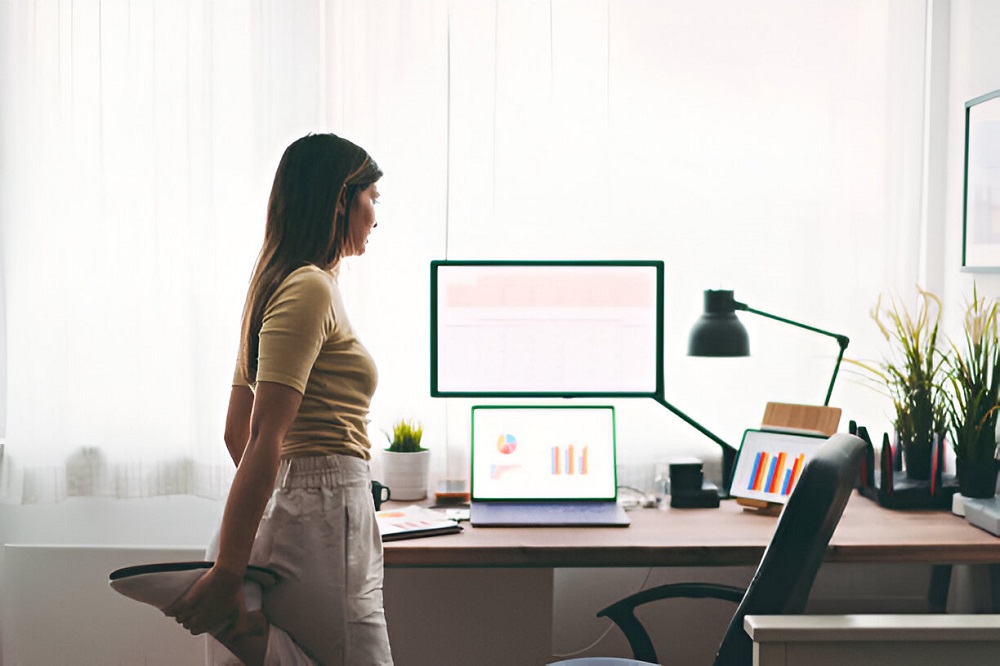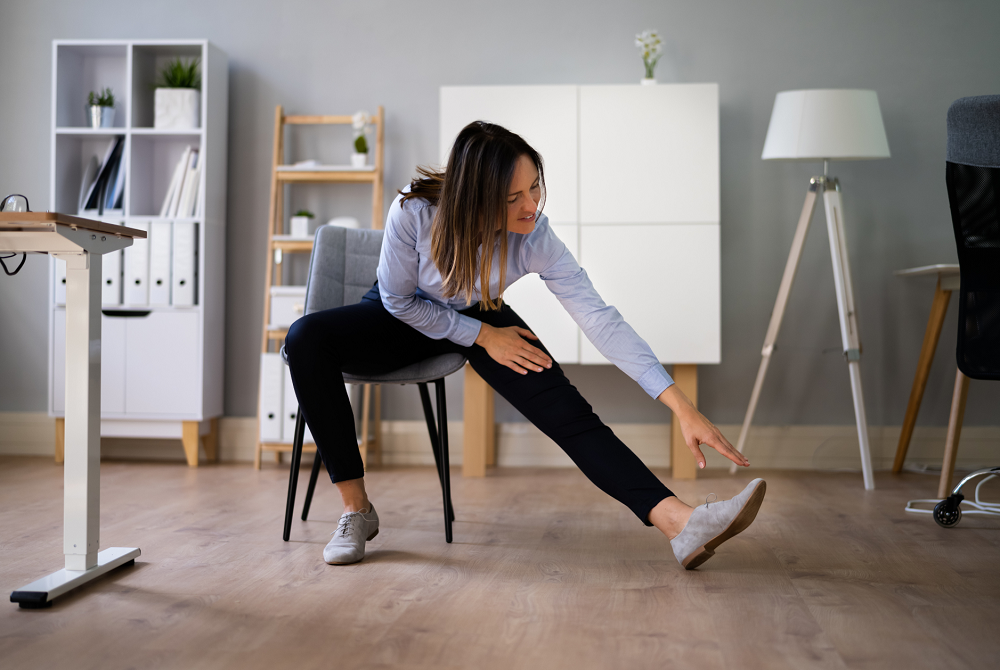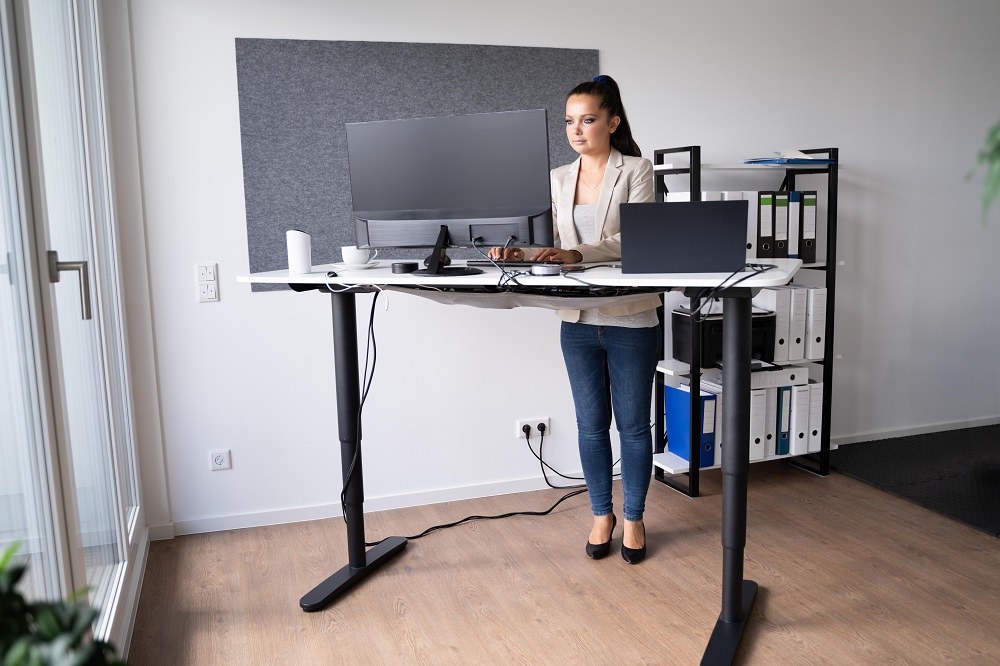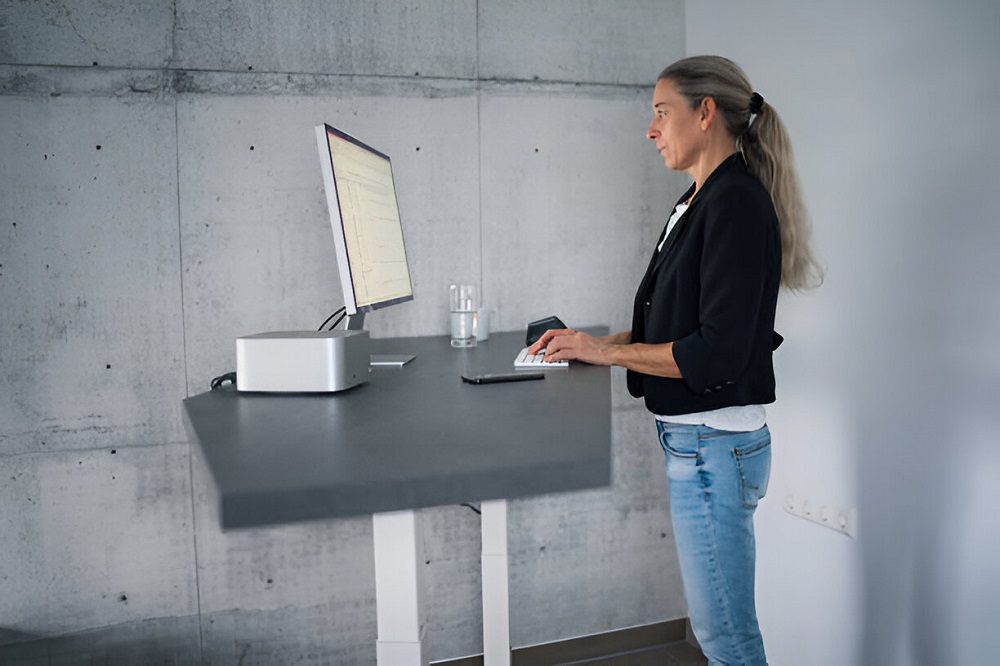In recent years, standing desks have gained popularity as a healthier alternative to traditional seated workstations.
They promise to alleviate the negative effects of prolonged sitting, which is often dubbed "new smoking" due to its association with various health issues.
However, simply standing all day isn’t the perfect solution either.
Incorporating exercises and stretches into your daily routine is essential to reaping the full benefits of a standing desk and avoiding potential drawbacks.
Standing Desks: An Ideal Office Ergonomic Find!
Standing desks offer several health benefits, making them an appealing option for office workers. Allowing you to alternate between sitting and standing helps reduce the risk of chronic diseases such as obesity, diabetes, cardiovascular disease, and certain types of cancer.
Standing more frequently can also improve posture, reduce back pain, increase energy levels, and even boost productivity.
The ergonomic advantage of standing desks is that they promote a more dynamic work environment, one in which movement is encouraged rather than prolonged stagnation.
But Wait,
Standing All Day Isn’t Perfect Either! Is it?
Despite the many benefits, standing all day has its own set of health issues. It can also cause muscle fatigue and joint issues, particularly in the knees and hips. Therefore, it’s crucial to balance standing and sitting while incorporating movements that prevent stiffness and discomfort.
Standing all day at standing desks may not be a good option for reasons beyond health concerns:
- Fatigue: Standing for prolonged periods can lead to physical fatigue, affecting energy levels and productivity over time.
- Discomfort: Standing continuously without breaks can cause discomfort in the feet, legs, and lower back, making it challenging to focus on tasks.
- Limited Movement: Standing desks may restrict movement compared to traditional desks, where employees can easily adjust their posture or take breaks by sitting down.
- Impact on Collaboration: Standing desks may not be conducive to collaborative work environments where sitting and face-to-face interactions are often preferred.
- Task Variation: Some tasks, such as detailed computer work or tasks requiring fine motor skills and concentration, may be more efficiently performed while seated.

Desk Exercises & Stretches: Solution to stiffness
Incorporating desk exercises and stretches into your daily routine can mitigate these issues, enhancing both physical well-being and productivity.
In fact, as per one study, periodic stretching at the workplace can reduce up to 72% of musculoskeletal pain. Such activities improve circulation, enhance muscle flexibility, and reduce the risk of developing musculoskeletal problems, ensuring that standing at your desk remains a healthy and sustainable practice.
Some of the doable desk exercises and stretches that you must incorporate into your daily routine are:
1. Calf Raises -
How to do it: Stand with your feet hip-width apart. Slowly lift your heels off the ground, rising onto the balls of your feet. Hold for a few seconds, then lower back down.
Benefit: Strengthens the calves, improves balance, and promotes circulation in the lower legs.
2. Leg Lifts:
How to do it: Stand straight and hold onto your desk for balance. Lift one leg straight out to the side, keeping it extended and your toes pointed forward. Lower it back down and repeat on the other side.
Benefits: Engages the hip abductors and improves hip flexibility.
3. Standing Marches:
How to do it: March in place by lifting your knees to hip level while keeping your back straight. Swing your arms naturally as you march.
Benefits: Increases heart rate, enhances coordination, and engages core muscles.
4. Desk Squats:
How to do it: Stand with your feet shoulder-width apart and lower your body into a squat position as if sitting back in a chair. Keep your back straight and knees behind your toes. Return to standing.
Benefits: Strengthens the quadriceps, hamstrings, and glutes.
5. Toe Touches:
How to do it: Stand with your feet shoulder-width apart. Bend at the waist and try to touch your toes, keeping your legs straight. Hold for a moment and then return to standing.
Benefits: Stretches the hamstrings and reduces standing desk back pain, promoting flexibility.
6. Quad Stretch:
How to do it: Stand on one leg and pull your other foot towards your buttocks, holding your ankle with your hand. Keep your knees together and stand tall. Hold for 15-30 seconds, then switch legs.
Benefits: Stretches the quadriceps, improving flexibility and reducing tightness in the front of the thighs.
7. Calf Stretch:
How to do it: Stand facing a wall with one foot forward and one foot back. Keep both feet flat on the ground and lean forward towards the wall, keeping your back leg straight. Hold for 15-30 seconds, then switch legs.
Benefits: Stretches the calf muscles, alleviates tension, and improves flexibility.
8. Hamstring Stretch:
How to do it: Place one foot on a low chair or desk. Keep your leg straight and bend forward at the hips, reaching towards your toes. Hold for 15-30 seconds, then switch legs.
Benefits: Stretches the hamstrings, relieves stiffness, reduces standing desk back pain, and promotes flexibility in the body.
9. Upper Back Stretch:
How to do it: Clasp your hands together and extend your arms in front of you at shoulder height. Push your hands forward, rounding your upper back and shoulders. Hold for 15-30 seconds.
Benefits: Stretches the upper back and shoulders, reducing tension and promoting better posture.
10. Neck Stretch:
How to do it: Tilt your head to one side, bringing your ear towards your shoulder. Use your hand to pull your head further into the stretch gently. Hold for 15-30 seconds, then switch sides.
Benefits: Stretches the neck muscles, reducing stiffness and preventing standing desk back pain
Such exercises and stretches while you are working at a standing desk, can significantly reduce stiffness and soreness, promoting overall physical well-being and productivity.

Other ways to get in the move!
The benefits of standing desks and exercises alongside stretches are crucial, but there are other ways to protect your body and get rid of stiffness.
Some of the activities that can help are:
1. Taking an Occasional Stroll:
Make it a habit to take short walks around your office every hour or so. Regular strolls improve blood circulation, reduce muscle stiffness, and provide a mental break, enhancing overall focus and productivity.
2. Adjusting Your Standing Desk:
Frequently change the height of your standing desk to alternate between sitting and standing every 30-60 minutes. This prevents prolonged pressure on any one part of your body, reducing the risk of musculoskeletal issues and maintaining ergonomic alignment.
3. Taking Walking Laps During a Quick Meeting:
Align your meetings for discussions with quick walk sessions that don't require a desk or computer. Walking laps during meetings keeps you active, improves circulation, and can lead to more dynamic and creative conversations.
What Must Employees Avoid While Working At Standing Desks?
While working at standing desks, there are certain practices employees must avoid in order to minimize fatigue and discomfort:
- Leaning on the Desk:
Leaning on the desk can disrupt proper posture and increase strain on the spine and shoulders. Maintain a balanced stance with weight evenly distributed between both feet.
- Wearing Unsupportive Footwear:
High heels or unsupportive shoes can contribute to foot discomfort and affect posture. Opt for supportive footwear with cushioning and good arch support.
- Slouching or Hunching Over:
Poor standing posture can strain the neck, shoulders, and lower back. Maintain an upright posture with shoulders relaxed and core engaged.
- Ignoring Ergonomic Setup:
Improper desk height or monitor placement can lead to awkward postures and discomfort. Ensure the desk height allows for elbows to be at a 90-degree angle and the top of the monitor at eye level to reduce strain on the neck and eyes.

Make Work Feel like a Breeze with Standing Desks:
You must spare minutes to relax whilst at your standing desks. Long hours of standing in a particular position can even hamper your productivity rather than improve it.
This is the major reason for inculcating a culture of periodic exercises and stretches while employees work at their desks. Standing desks come in varied sizes and are a great investment overall, but intentional movements throughout the day should not be compromised.
As an employer, you must:
- Encourage employees to take time to relax and unwind
- Change work positions frequently so that an employee does not have to work in a single place
- Work pressure should be prioritized appropriately and at regular intervals
- Employees should be provided with proper instructions to make the most of their work time and do stretching as well
Bottom line,
Incorporating desk exercises, stretches, and other movement activities into your daily routine can significantly alleviate the stiffness and fatigue of standing for long hours.
Workplaces should prioritize including standing desks in their ergonomic setups to maximize employees' performance.
By allowing employees to switch between sitting and standing, companies can foster a healthier work environment, increase productivity, and support the overall well-being of their workforce.
To order the best standing desks for your employees, Onergon is a reliable provider of premium quality standing desks that improve work productivity.
Visit our website and place your bulk order!




